It’s easy to attribute the yellowing of your grass to lawn diseases, but in some cases, improper lawn care practices are the actual culprits. Throughout my two decades of experience, I’ve observed various factors that can result in small patches of yellowing in your lawn.
Quick Answer
Grass turning yellow may be due to lawn diseases. But issues like frost burn, dog urine, excessive fertilization, and overwatering can also be a common cause.
This guide presents each factor in more detail and provides you with practical solutions to address the issue of yellow grass in your lawn.
For a straightforward solution to address most yellowing spots in lawns, consider signing up for a Sunday Lawn Care plan tailored to your grass type and lawn needs.
DIY Lawn Care, Simplified!
Crabgrass Lawn has partnered with Sunday to get your lawn exactly what it needs to thrive. Use the code “CGLAWN20” to get $20 off.
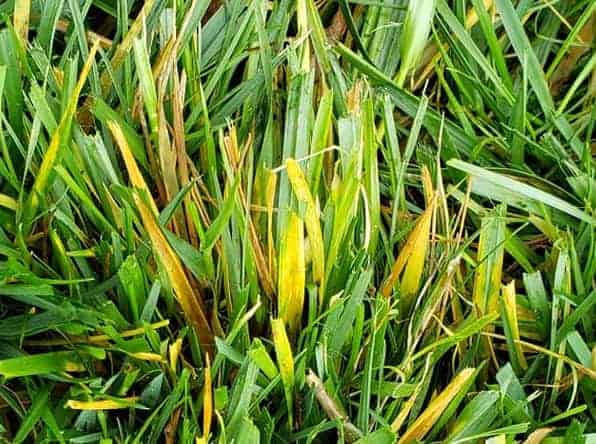
13 Most Common Reasons Why Your Grass is Turning Yellow
Any grass type can turn yellow, be it St. Augustine grass, Bermudagrass, Buffalo grass, Kentucky Bluegrass, or any other variety. It is the lawn care activities that may be lead to the discoloration of grass blades.
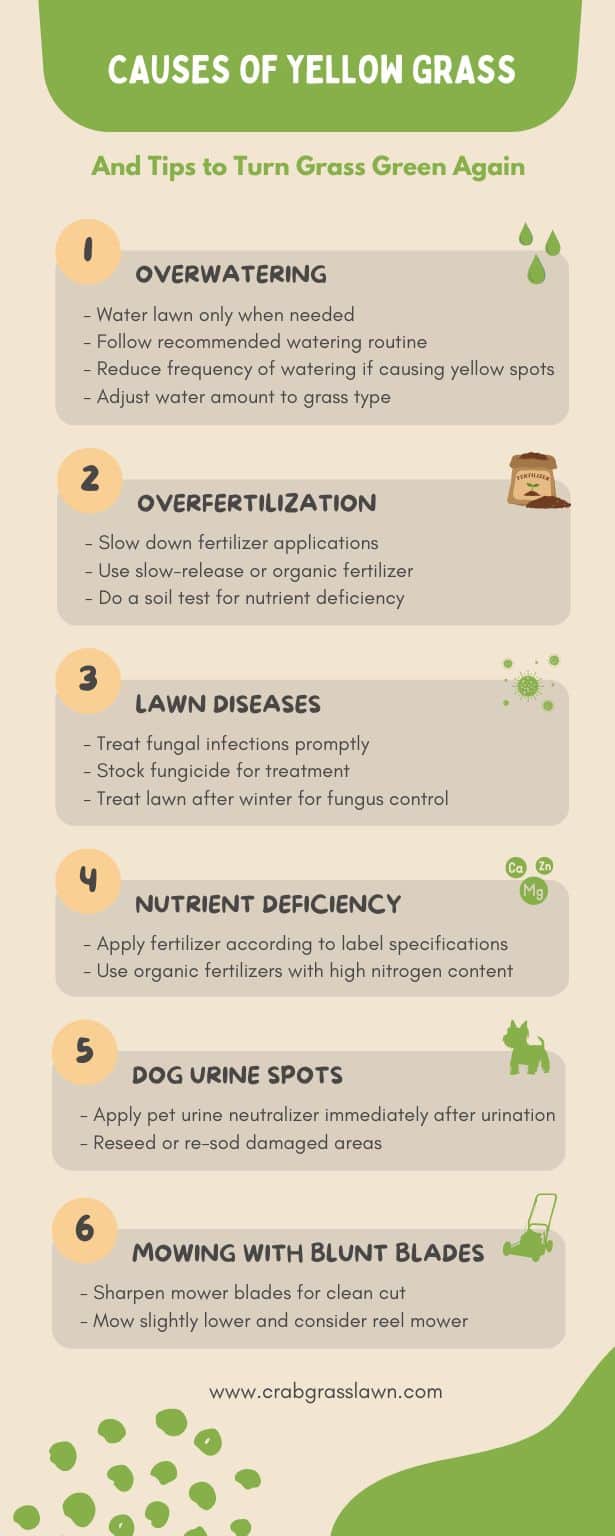
1. Overwatering
Overwatering causes your grass to have poor root development. Too much water leads to a limited supply of oxygen in the soil due to waterlogging. Your grass will have shallow roots and will suffer from poor uptake of nutrients like oxygen, and even water itself, causing the lawn to start turning yellow.
Overwatering your lawn will also cause fungal diseases and insect infestation due to reduced resistance.
So, can overwatering cause yellow grass? Yes, absolutely. Just remember that feeding your grass with adequate nitrogen and enough water helps the lawn resist disease attacks.
If you suffocate the roots with water, you won’t be able to feed your lawn properly and you’ll start seeing signs such as thinning and discolored leaf blades. Here are some other consequences of overwatering your lawn.
2. Overfertilization
Too much fertilizer can easily burn your lawn. This is especially true for synthetic fertilizers. You may see your grass turning yellow after applying fertilizer, indicating that you applied too much.
Excess nitrogen salts in synthetic fertilizers usually burn the leaves of your turfgrass. Sometimes, this is called leaf scorch.
The signs of overfertilization include:
- Yellowing of leaf blades at the base.
- Browning of grass blades at the top.
- Slow growth of grass.
- Fertilizer crust on the soil surface.
3. Lawn Diseases
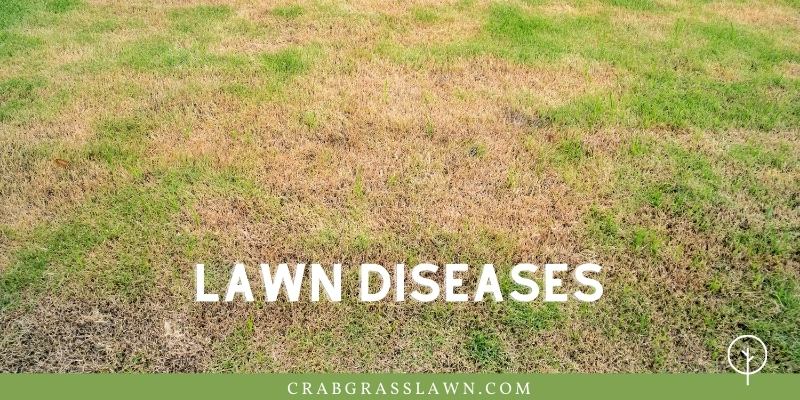
Some lawn diseases manifest as yellow to brown patches. Lawn fungus, dollar spot, and other diseases start to show signs of yellowing leaves or undergrowth.
Frost burn during winter and excessive rain can often be followed by yellowing leaf blades but the grass may not die from it. Treatment, however, may be necessary to stop the grass discoloring even further.
4. Nutrient Deficiency
A lawn with yellowing spots and strips may be suffering from nutrient deficiency. If there are areas in your lawn where you miss applying fertilizer, you’ll notice a faint yellow or fluorescent discoloration on the leaf blades while the rest of the grass shows signs of deep greening and thicker, faster growth.
According to the University of Massachusetts Turf Extension, one of the signs of nutrient deficiency caused by improper fertilization is “Brown streaks lined with extra green growth can occur in areas of application overlap. Yellow nutrient deficient streaks may occur in missed areas.”
Have you performed a soil test recently? If not, here’s why you should immediately if your grass is turning yellow.
5. Dog Urine Spots
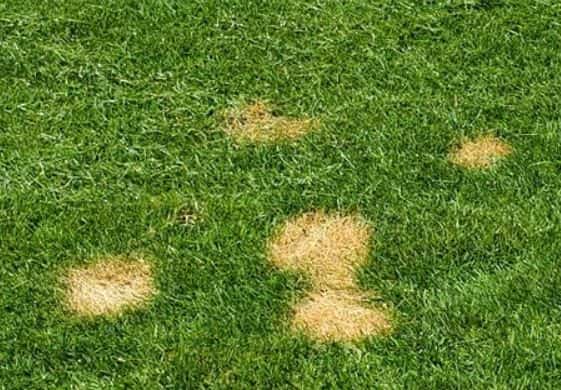
Dog urine naturally contains high nitrogen compounds. If you have dogs that pee on your lawn, you may start to see yellow spots all over the yard. Even though you heard me say nitrogen is good for your lawn, too much of anything isn’t always a good thing.
Excess nitrogen can burn your grass and create yellow patches. The concentration of nitrogen in dog urine depends on several factors including the breed of dog, its sex, and what the dog eats.
Speaking of sex, female dogs, because of the way they squat while peeing cause more damage than male dogs. If you have a female dog, you’ll notice yellow patches of grass all across your lawn or wherever your dog urinates.
Add to this is the size of the dog, given that smaller dogs pee less than larger dogs, they cause less damage. I’ve tried two ways to reduce these unsightly yellow patches on my lawn.
The first is to dilute your dog’s urine by adding water to its food or designate a certain area of your yard to take care of doggy business such as a gravel patch or rock garden. You can also give your dog Grass Green Dog Chews to neutralize its urine and improve digestion.
| Preview | Product | Rating | |
|---|---|---|---|

|
Dog Pee Grass Chews with Prebiotics, A Dog Pee Grass Neutralizer... | Check Price |
Affiliate links and images pulled from the Amazon Product Advertising API on: 2025-07-01
6. Pests
There are several pests that can cause yellowing grass including webworms, leatherjackets, cutworms, and much more. The insect larvae of these pests feed on the roots of healthy grass, causing the grass blades to turn yellow and eventually brown.
It is important to identify the type of larvae your lawn is harboring before treating an infestation with an appropriate herbicide. Since larvae are hard to see with the naked eye, get a magnifying glass and inspect the thatch for larvae or insects.
7. Mowing Mistakes
Mowing may seem like a fairly straightforward task, I mean just power on the mower and run it across your lawn right? Well, many things can go wrong when you take this route, resulting in yellow grass.
Believe it or not, the way we maintain our lawn care equipment plays a pivotal role in the health of our yard.
Let’s start with dull mower blades, which tear the grass and fray the edges, consequently drying out the tips of grass and turning them yellow.
What’s worse is that dull mower blades can cause your turf to look ragged after cutting and make your turf more susceptible to disease.
The easiest and quickest way to sharpen dull mower blades is with a bench grinder. Ensure you wear protective gear when grinding the edges of dull mower blades.
The next and often overlooked mowing mistake that causes yellow grass is cutting the grass too short also called scalping. When you cut the grass too short, it doesn’t receive enough moisture and, therefore turns the grass yellow after a few days.
In the event this happens, allow your grass to grow longer and water sufficiently. Next time you mow your lawn, increase the cutting height of the mower.
A thumb rule to remember is that cool-season grasses should typically be cut to roughly 3 – 4 inches high and 2 to 2 ½ inches high for warm-season grasses.
8. Compacted Soil
Compacted soil happens when soil particles are pressed together, leaving no space between them. If the soil underneath is too compact, grassroots won’t be able to penetrate deep into the soil, weakening the grass and turning it yellow.
There are a few ways to determine if the soil is compacted, starting with taking a sample of the soil. If it’s compacted, the soil will be hard and grey in color.
Next, observe your lawn after you water it. If water floods in certain parts of your lawn and runs off higher parts of your turf quickly, great chances are your soil is compacted.
Reasons for compacted soil include overwatering and excessive foot traffic and can be caused by a very thick thatch layer.
You can reduce compacted soil by adding perlite and vermiculite to promote soil aeration in the compacted layer of the soil. Adding to this, check your soil regularly to check the resistance levels of the soil and add organic matter to create some distance between the soil particles.
| Preview | Product | Rating | |
|---|---|---|---|

|
8QT Horticultural Vermiculite Bulk, Organic Vermiculite for... | Check Price | |

|
PVP Industries 120 Quart Perlite Planting Soil Additive and 103... | Check Price |
Affiliate links and images pulled from the Amazon Product Advertising API on: 2025-07-01
9. Dying or Dormant Lawn
Lawns entering the dormancy period tend to turn a yellow-brown straw-like color, so you may think it’s dying before your eyes.
You can check if your lawn is dormant or dead by pulling a few grass blades off the ground. If they come out easily, your grassroots has decayed and the grass is dead. Here are a few other ways to determine if your grass is dormant or dead.
A dying lawn will start turning yellow first and then brown. Your lawn needs water and other nutrients to thrive, without which it will start to wilt, turn yellow and brown and die eventually.
10. Walking on the Lawn
As mentioned earlier, soil compaction is a common reason for yellow grass, and is caused when your lawn is walked on too much or driven over by vehicles, especially when it’s dry.
This pressure eliminates the space necessary between the soil for oxygen, water, and other nutrients, turning grass yellow. Avoid excessive walking and never drive any vehicle on your lawn.
11. Weeds
If your lawn is riddled with weeds, it could be a good sign of a weed infestation. Weeds rob your grass of essential nutrients hence turning the grass blades yellow.
Some common weeds that cause yellow grass are crabgrass, dandelion, and quackgrass. Weeds grow on lawns for several reasons, most of which are caused by bad lawn care practices including mowing your lawn too short, insufficient watering, compact soil or soil that’s too clayey or too acidic, or poor soil quality.
A well-maintained lawn eliminates the conditions for the growth of weeds and other unwanted plants. Therefore, to prevent weed growth on your turf, it’s important to take care of the health of your lawn.
Getting rid of weeds isn’t easy but there are certain herbicides you can use to get the job done. Make sure you read the instructions on the label as some herbicides will eliminate weeds and grass too.
12. Weather and Heat
Prolonged heat waves can turn your green grass yellow and brown. The good news is that yellow grass caused by a heatwave usually recovers after the heatwave has passed. In the meantime, water more often and deeply to correct the issue.
13. Gas Spills on Grass
We all do it – fill up our gas-powered mowers on green grass. But gas spillage if not cleaned up immediately can kill your grass.
Gasoline has the ability to desiccate and burn grass upon contact and the extent of damage depends on how much gas was spilled.
What’s worse is that gasoline can also contaminate the soil and kill beneficial bacteria that live underneath. If you’ve spilled gas on your lawn, water the area thoroughly and add some sand for aeration.
Is Yellow Grass Dead?
Yellow grass may seem like it’s dead but in most cases can still be revived into a healthy lawn.
The biggest reason your grass turns yellow is due to overwatering or underwatering.
Many homeowners believe that the more water they provide, the better the grass will grow. Unfortunately, this is a common misconception that usually results in a yellow and dead lawn.
Going overboard with watering basically drenches the grassroots and leads to a lack of oxygen in the soil. Not watering your lawn enough has its own consequences including drought-like conditions that cause your grass to turn yellow and die altogether.
However, at this point, the yellow grass isn’t dead and can be brought to a green state by maintaining a watering schedule and sticking to it.
Pests and lawn diseases can also create yellow grass, which may seem dead. However, applying the right herbicides can rectify the situation.
Dormant grass may also turn grass yellow but this is just a phase your grass goes through in the winter and the grass will green up in the spring when the soil warms up.
How to Turn Yellow Grass Green Fast
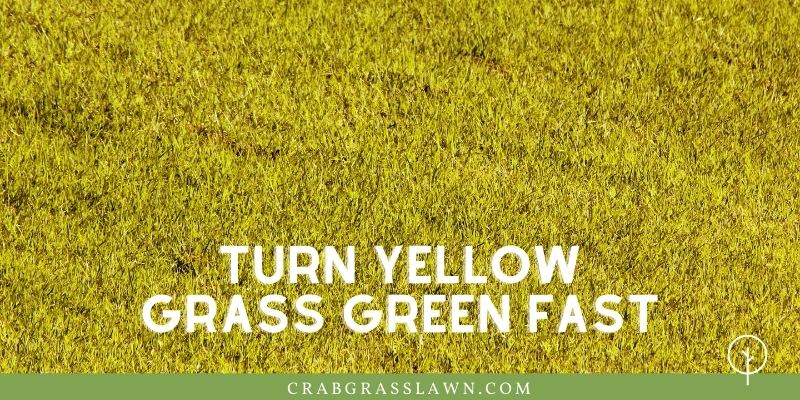
As soon as you notice yellow spots and streaks on grass blades, you should start mitigation measures.
Here’s how to make your grass green again:
1. Reseed Urine Spots
Sometimes, dog urine spots do not grow back especially when you take too much time before applying a dog urine neutralizer.
To prevent your grass from turning yellow and dying after a dog pees on it, you might want to follow the pet in the yard and apply a neutralizer immediately after he pees.
Alternatively, you can get rid of the yellowing and dying spots in your lawn by simply reseeding or re-sodding your lawn if the damage has already been done.
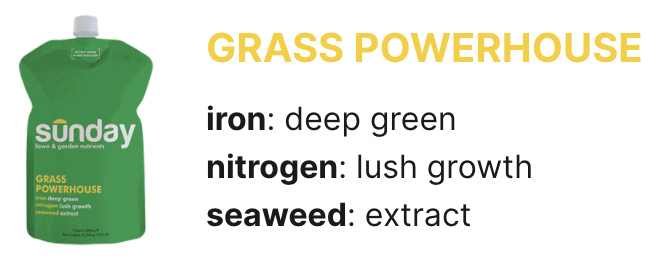
Sunday Lawn Plans come with a pet neutralizer and Green Powerhouse product that you simply spray on your lawn when you have yellowing grass issues. Consider signing up for Sunday Lawn Care to treat your yellowing issues for good.
2. Adjust Your Watering Routine
Only water your lawn when needed. If there’s a lot of rain when you notice your grass turning yellow, you may want to stop watering for some time before resuming.
- Only water your lawn when the two inches of topsoil is dry.
- Ensure your water according to the maintenance program of your particular grass.
- Most lawns benefit when you water them 2-3 times a week. If this causes yellow spots, reduce the frequency to 1 or 2 times only.
- Try reducing the amount of water when irrigating your lawn to the recommended level for your grass type.
Different grass types require different watering routines. St Augustine grass turning yellow could be a sign of fungal infection and water-logging.
To prevent this, talk to a lawn care expert in your area to advise you on the proper care routine for St. Augustine grass in order to get rid of the yellow spots on your lawn by changing the watering routine.
3. Fertilize Your Lawn When Needed
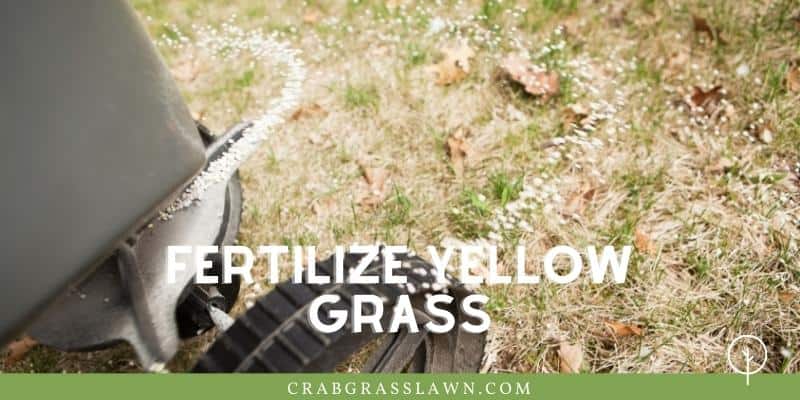
When your grass is turning yellow after fertilizing, it means you applied too much fertilizer. You can fix this by slowing down your applications. Alternatively, you may want to use a good slow-release fertilizer, preferably an organic one. It will not burn your lawn or cause yellow spots.
- Do a soil test to determine what nutrient is deficient and buy a fertilizer with the right NPK amounts.
- Apply fertilizer according to the specification on the label.
- Feed your lawn with the right amounts to help nutrient-deficient yellowing grass turn green again.
I always prefer using organic fertilizers with high nitrogen content. They hardly burn your lawn even if you miss the instructions on the label.
4. Treat Lawn Diseases
Lawn diseases slow the growth of your lawn and can produce symptoms on the blades such as spotting and wilting. To turn yellow grass green faster, treat any fungal infections or other diseases as soon as you see symptoms.
Most lawn diseases are fungal infections and are caused by dampness. Therefore, ensure you always stock a fungicide such as DiseaseX to treat grey spot, brown patch, and any other similar diseases.
Also, you may need to treat your lawn just after winter to kill any fungus that may have developed during the frost days. This will help turn your grass green fast.
5. Mow With Sharper Blades
When it is spring or autumn, does your grass turn yellow after mowing? Then there’s a problem with your lawn mower’s blades – they’re blunt.
Blunt blades hack the grass blades, leaving them open and prone to disease. The crowns of your grass will then start to turn yellow.
Shop for new mower blades at Amazon
There are two ways to fix this and help your grass grow greener again. First, sharpen your mower blades.
You really want to get a clean cut that appears as though you just snip on the grass blades. Second, mow at a height slightly lower than your last mow to allow new greener shoots to come up. You may even want to consider using a reel mower that does a cleaner cut compared to gas-powered mowers.
Tips To Prevent Grass Turning Yellow
If you’ve read so far, you already know how to prevent grass turning yellow but here are a few tips to keep in mind.
1. Mower Blades
Start by sharpening your mower blades. Many homeowners including me often just run lawnmowers across the lawn without checking whether the mower blades are sharp enough to make crisp cuts.
Just like using a dull knife in the kitchen, mowing with dull mower blades will not provide a clean cut and to make things worse will damage your grass, causing it to fray and turn yellow.
Yellowing and damaged grass also leaves your lawn susceptible to pests and diseases, something no homeowner wants to deal with.
Most lawnmower blades should be sharpened about 2 – 3 times per year, more if you have a sprawling lawn or you cut grass frequently.
You can sharpen your mower yourself with a bench grinder at home or have a professional do it for you. I’ve invested in a spare set of mower blades to ensure I always have sharp blades ready to go.
2. Cutting Height
So you’ve gassed up your mower or have loaded your mower with a fully charged battery and sharpened the blades, you’re all set to cut the lawn, right? Wait, not so fast!
Are you aware of the right cutting height? Yes, it matters, a lot! If you mow too high or too low, your lawn can suffer from stress, hence turning the grass yellow.
When you mow the lawn, remember to only take a third of the height each time so set your mower’s height accordingly.
Adding to this, it is always a good idea to leave the grass clippings on the lawn or grasscycle, which saves you the trouble of bagging the clippings and on the flipside provides more nutrients for your lawn.
3. Fertilization
Last but equally important is overfertilization. Fertilizing your lawn can be a tricky task because you have to apply the right fertilizer in the appropriate quantities and at the right time.
If you aren’t sure about the best fertilizer for your lawn, avoid picking up the first fancy bag at your local gardening center but perform a soil test instead. After fertilizing your lawn, give your turf a good watering during the cooler hours of the morning.
FAQs
Why Is My Newly Laid Turf Turning Yellow?
One of the common reasons a newly laid turf turns yellow especially if you’ve done everything right like planting the best grass seed for your area and fertilizing properly is stress from direct sun exposure.
Lawns affected by heat stress should be watered deep and infrequently 2 – 3 times a week, and mowed with sharp mower blades at the right height.
Best Fertilizer for Yellow Grass?
It’s hard to recommend the best fertilizer for yellow grass without determining the underlying reason for the issue and without a soil test.
However, Milorganite organic nitrogen fertilizer always works for my grass that’s yellowing, growing slowly, and/or is susceptible to weeds.
Final Thoughts
Is your grass turning yellow? Well, there’s no reason to break a sweat just yet! Grass can turn yellow for several reasons including dormancy, pests, and overwatering, all three of which are easy to fix.
Further, check your mower blades to ensure they are sharpened and cut the grass at its appropriate height. Before applying fertilizer, read the instructions on the label and spread fertilizer evenly and in the right quantity.
After implementing proper lawn care techniques, it shouldn’t take long for yellow grass to turn green again.
References
- The University of Massachusetts Amherst: What’s Wrong with My Turf
- University of Georgia Extension: Turfgrass Diseases in Georgia: Identification and Control
Hi, Alex Kuritz here. Growing up I remember that my family had one of the best lawns in the neighborhood. Richly green and lush. I did a lot as I grew up in terms of caring and tending for not only my family’s lawn but also my neighbors. I can say I have years of experience, and I am here to share it with you.



THANKS FOR YOUR ADVICE MY NEW SEEDED LAWN WAS LOOKING BEAUTIFUL THEN WE CUT IT NOW PLACE ARE TURNING YELLOW VERY DISAPPOINTED I BELIEVE THE MOWER SHOULD BE SHARPEN AND CUT HIGH AND THE CUTTER KEEP GOING OVER IT WITH THE MOWER CUTTING IT LOWER AND LOWER , THANKS FOR YOUR INFORMATION I LOOK FOR TO HEARING FROM YOU AND I AM GOING TO TEST THE SOIL FOR POSSIBLE PROBLEMS. THANKING YOU IN ADVICE YOU MAY HAVE.
Yes everything you said are things to start doing now. Good to test the soil so you can balance that if out of whack. Sharp blades are a must and cut high as you can until it starts to come back green and lush. Then you can start playing with the height.
Good Afternoon,
I just put in new sod seeds and dirt. The grass has been cut almost every week after I put in the new grass. The grass is turning yellow and turning all burnt. I’m not sure if over watering or not. We have two dogs and of course there are pee stains on the grass. We all know that happens. Do not know exactly what’s going on. Is it because the grass has been cut so many times after putting in new sod, seeds and dirt?
Please need you help!
Hey Nadine, thanks for writing in. It could be a combination of things. It may be due to cutting it before it gets established and a strong root base. It could be overwatering and it could be due to poor soil. The dogs are going to do what they do and can’t do much about that. But for getting the lawn established I would not cut it for a few weeks and cut back on the watering if you think you are watering too much. What type of grass do you have BTW?
Hi Alex,
I recently put fertilizer on my lawn & I think it got fertilizer burn because there’s lots of yellow spots all over the lawn. Since then I’ve been watering the yellow spots significantly to flush away any excess fertilizer & hopefully help it turn green. However the yellow spots aren’t going away even after it has rained & I water it with the hose. I really saturate the yellow spots with water but nothing seems to help.
Any thought or recommendations?
HI Sara, it actually may be overwatered at this point. I would let it rest a few days as the fertilizer should already be soaked in enough but now it sounds like it needs to dry out to normalize. Also feel free to join our new Facebook group so you can post pics and to get a discussion happening: https://www.facebook.com/groups/LawnAndLandscapingHacks/.
I’ve always kept my lawn in good standing. I got rid of a shed in my back yard 1yr ago & noticed a big bare spot I’ve tried to reseed with Pennington pencoated seed. Well, the seed didn’t come up as expected. This year I still have the bare spot and in other areas the grass looks yellow. I was going to put more seed & cover it with miracle grow & water it 1 or 2 times a day. What is your thought on this please?
Hi Dee, thanks for writing in. Seeding typically takes a few rounds for it to fill it thick. Don’t do the miracle grow with it though as that may be hindering it. But yes do a few more rounds of seed and make sure it stays wet (not soaked) for the most part for a good week or until its about 1/2″ tall.
My st Augustine grass was really green and now it started turning yellow all around except the middle. I planted in April and had not fertilized it till this week. I water it everyday except two days: how long does it take for fertilizer to work?
HI Alma, it may be overwatered. Fertilizer typically kicks in within a week. But many yellowing issues come down to overwatering.
hello, my back and front lawn healthy and green in 20 years my neighbor envy.
Lately so sudden backyard lawn became yellow from edge. next day morning front yard lawn edge became yellow. In the middle lawn backyard and front yard are o.k. What happened? we are afraid yellowing spread all the lawn.
Oh, my husband sprayed insect killer in backyard. Does this spray cause lawn yellow? He sprayed only backyard. this morning we found all front yard edges all the way yellow. What happened?
Hey Alex,
I recently seeded my lawn and the grass is about 2 months old now, I just came out of a cold snap that brought the temps down to 30s now they’re back up to the 70’s. I’ve never fertalized the lawn before and the grass was all green and fine until now. The tips of the grass blade are starting to turn yellow in some places and the midsection of the blades are also turning yellow. Help please
What part of the country are you in and do you know the grass seed type you put down?
I live in the Pacific Northwest, and my lawn was lush, green, and doing well. I cut it slightly longer, use turf builder as recommended, and it is watered with an irrigation system. Within a week, I had yellowing to straw-colored areas pop up everywhere? some of them were 2-3 feet in area. Any ideas? HELP!
Hi David, thanks for writing in. This may be a good one for our FB group where you can upload a picture to start a discussion: https://www.facebook.com/groups/866415330515149
Hi Alex,
I recently noticed some part of my lawn turning yellow. The lawn is a little slopey and the bottom section is what i see to be turning a little yellowish. Is this a case of overwatering. ?
Hi Kwame, My initial thought is that is where the water is collecting and pooling. Is that area always wet or muddy? If so you may want to put in some sort of drainage system to move the water away.